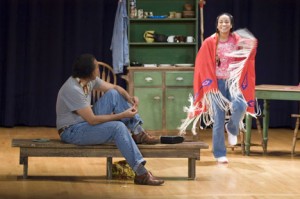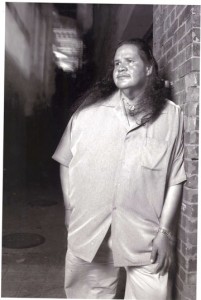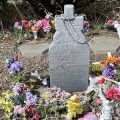“Grandchildren of the Buffalo Soldiers”
The relationship between African Americans and Native Americans has a long and complex history. William S. Yellow Robe’s (Assiniboine) compelling drama, “Grandchildren of the Buffalo Soldiers” explores the historic clash of two fiercely proud yet oppressed cultures pitted against one another by American expansion into the western territories. The play will make its Washington, D.C., premiere April 22 in collaboration with the National Museum of the American Indian and the National Museum of African American History and Culture.
“Grandchildren of the Buffalo Soldiers” depicts the homecoming of Craig Robe, descended from a Native American woman and an African American “buffalo soldier.” Ridiculed as “too black” to be Native, the Robe family has struggled for acceptance not only from their tribe, but from each other. Through skillfully balanced humor and pathos, this fearless, heart-felt play asks audiences to consider racial and cultural identity, while maintaining a compassionate and open-minded view of the complexity of mixed-race heritage in America.
Recommended for middle-school grades and higher, “Grandchildren of the Buffalo Soldiers” is part of an ongoing series of programs in support of the museum’s exhibition, “IndiVisible: African-Native American Lives in the Americas,” which is open through May 31.
Yellow Robe is a member of the Assiniboine Nation located on the Fort Peck Indian reservation in northeastern Montana. He is an actor, playwright, director, poet and instructor. He has written more than 50 plays, including full-length and one-act works, a book for a musical and children’s plays. Yellow Robe is an adjunct faculty member at the University of Maine in Orono. Among other awards, he is a recipient of the Indigenous People Organization Award, Theater Communications Group National Residency Grand, Princess Grace Fellowship, Jerome Foundation Grant, New England Theater Conference Award for Excellence and was awarded the First Book Award for Drama from the Returning the Gift conference.
“Grandchildren of the Buffalo Soldiers” runs Thursday, April 22 (museum members only), through Sunday, April 25, and Thursday, April 29, through Sunday, May 2, at 7:30 p.m., Thursdays through Saturdays and 2 p.m. on Sundays, in the American Indian Museum’s Rasmuson Theater in Washington, D.C. The press preview performance is Thursday, April 22. Tickets are free to the public and available on a first-come, first-served basis.
The Rasmuson Theater design is inspired by the metaphor of a perfect storytelling venue: a clearing in the woods under a bright night sky. Native stories are often told in winter or at night, and visual references to this setting include the moon, the texture of ice and Raven, a trickster character often found in American Indian stories. Vertical wood paneling surrounds the 322-seat circular theater, evoking a dense hardwood forest, and above, a dark ceiling twinkles with fiber-optic constellations. Cast-glass sconces along the back wall recall the phases of the moon.

A Comanche family in the early 1900s. The elder man is Ta-Ten-e-quer and his wife is Ta-Tat-ty. Their niece, center, is Wife-per, also known as Frances E. Wright. Her father was a Buffalo Soldier, an African American cavalryman, who married into the Comanches. Henry, center left, and Lorenzano, center right, are her sons. (Photo courtesy of Sam Devenney. Originally published by www.indiancountrytoday.com)
“Native American theater is unique—not many stages or theaters produce it,” said Kevin Gover (Pawnee), director of the American Indian Museum. “We are proud to educate and entertain our audiences through the medium of Native theater and especially proud to collaborate with our colleagues at the Museum of African American History and Culture.”
“African Americans, like Native Americans, are proud of our oral tradition,” said Lonnie Bunch, director of MAAHC. “Much of our history is passed down through the recitation and reenactment of stories. ‘Grandchildren of the Buffalo Soldiers’ carries on that custom in a way that is particularly suited to young people.”
Posted: 9 March 2010










